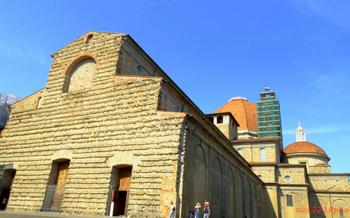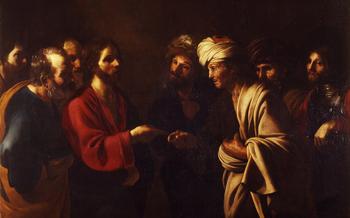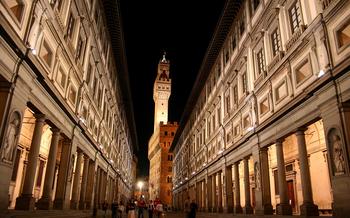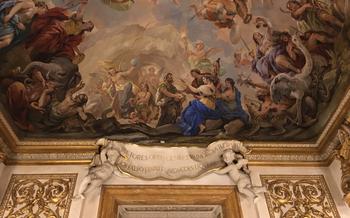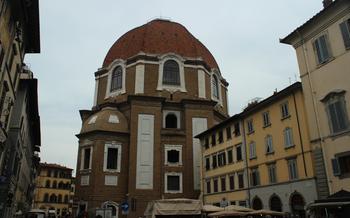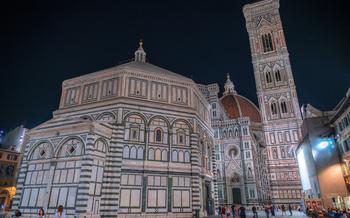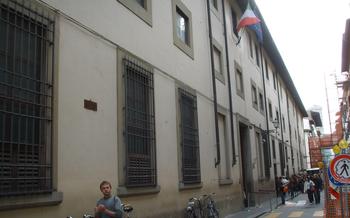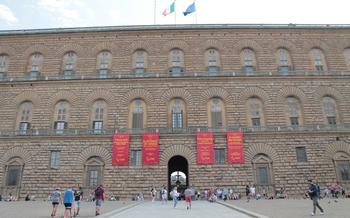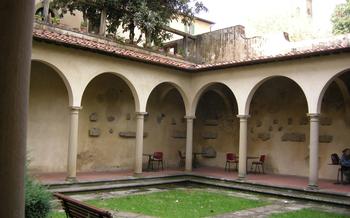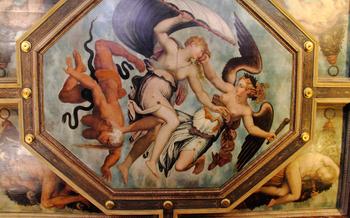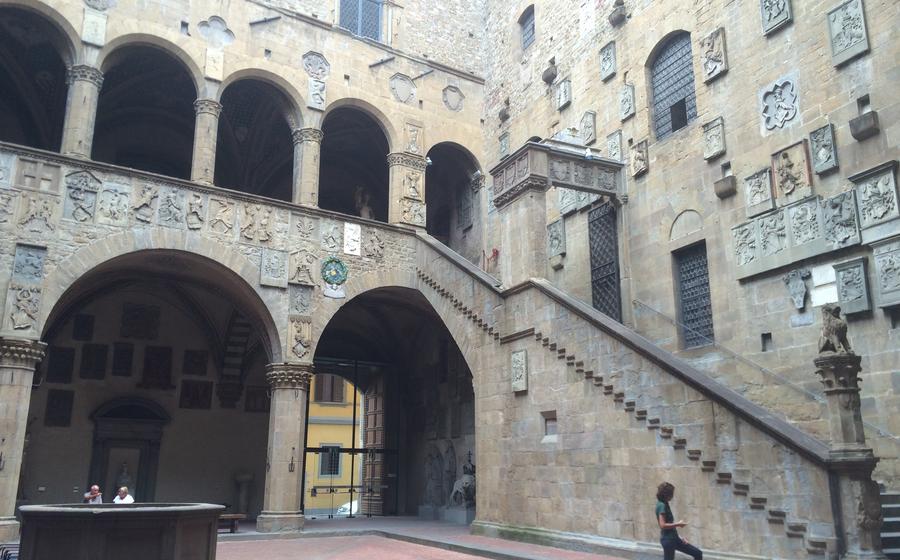
Bargello Museum
- Introduction - The Bargello Museum: Florence's Treasure Trove of Renaissance Art
- Sculptural Masterpieces
- Renaissance Bronzes: Masterpieces in Metal
- Medieval and Gothic Art
- The Medici Collections: Shaping the Museum's Identity
- Temporary Exhibitions
- Guided Tours and Workshops
- Museum Shop and Cafeteria
- Photography and Videography
- Accessibility and Facilities
- Surrounding Area and Attractions
- Online Resources and Virtual Tours
- Conservation and Restoration Efforts
- Educational Programs and Outreach
- Insider Tip - Hidden Gems
Introduction - The Bargello Museum: Florence's Treasure Trove of Renaissance Art
Nestled in the heart of Florence, Italy, the Bargello Museum stands as a testament to the city's rich artistic heritage and its pivotal role in the development of Renaissance art. Once the Palazzo del Podestà, the seat of Florence's medieval government, the building itself is a masterpiece of 13th-century architecture, with its imposing facade and elegant courtyard.
Originally constructed as a fortress, the Palazzo del Podestà underwent several transformations over the centuries, reflecting the changing political and cultural landscape of Florence. In the 16th century, the palace was converted into a prison, housing notorious inmates such as the infamous serial killer, Filippo Pacciani.
In 1865, the Palazzo del Podestà was transformed once again, this time into a museum dedicated to Renaissance sculpture. The Bargello Museum was born, and it quickly became one of the most important repositories of Renaissance art in the world.
Today, the Bargello Museum houses an extraordinary collection of sculptures, bronzes, and other artworks from the 13th to the 17th centuries, making it a must-visit destination for art enthusiasts and history buffs alike. Its collection boasts masterpieces by some of the greatest artists of the Renaissance, including Donatello, Michelangelo, and Benvenuto Cellini, offering a comprehensive overview of the development of Renaissance sculpture in Florence.
The Bargello Museum is located in the historic center of Florence, just a short walk from other iconic landmarks such as the Uffizi Gallery, the Accademia Gallery, and the Duomo. It is easily accessible by public transportation and is open to the public from Tuesday to Sunday, with extended hours on some days.
Sculptural Masterpieces
Among the museum's treasures, several iconic sculptures stand out, each representing the mastery and innovation of Renaissance artists.
Donatello's David: Created around 1440, Donatello's David is a masterpiece of the early Renaissance, breaking away from traditional depictions of the biblical hero. The sculpture is characterized by its contrapposto pose, capturing David in a moment of contemplation, and its naturalistic rendering of the human form. Donatello's David played a pivotal role in the development of Renaissance sculpture, influencing future generations of artists.
Michelangelo's Bacchus: Michelangelo's Bacchus, carved between 1496 and 1497, showcases the artist's early genius and experimentation. Depicting the Roman god of wine, the sculpture is imbued with a sense of movement and energy, capturing Bacchus in a state of inebriation. Although unfinished, the Bacchus reveals Michelangelo's mastery of anatomy and his ability to convey emotions through his sculptures.
Benvenuto Cellini's Perseus: Cellini's Perseus, completed in 1554, is a bronze masterpiece that exemplifies the technical virtuosity of the Mannerist period. The intricate details and the vibrant depiction of the mythological hero slaying the Medusa capture the essence of the Renaissance fascination with Classical mythology. Cellini's Perseus is considered one of the most significant bronzes of the Italian Renaissance.
In addition to these iconic works, the museum houses an impressive collection of sculptures by other renowned artists, including Giambologna's Mercury, Ammannati's Neptune Fountain, and Bandinelli's Hercules and Cacus.
Renaissance Bronzes: Masterpieces in Metal
The Bargello Museum is renowned for its exceptional collection of Renaissance bronzes, which showcase the technical prowess and artistic virtuosity of the period. These intricate sculptures, cast using the lost-wax technique, encompass a wide range of subjects, from mythological figures and religious iconography to portraiture.
Among the most notable bronzes is Donatello's majestic David, a life-size masterpiece that captures the youthful hero's triumph over Goliath. The sculpture's graceful posture, intricate details, and expressive countenance exemplify Donatello's mastery of bronze casting and his ability to imbue his works with a sense of vitality and realism.
Another highlight is Antonio del Pollaiuolo's dynamic Hercules and Antaeus, which depicts the mythical hero grappling with his opponent in a powerful struggle. The intricate musculature and energetic movement of the figures showcase Pollaiuolo's anatomical knowledge and his skill in capturing the essence of human motion in bronze.
The Bargello Museum also houses an impressive collection of bronze statuettes, which offer a glimpse into the diverse themes and styles of Renaissance bronze sculpture. These small-scale works often depicted mythological scenes, animals, or portrait busts, and were highly prized by collectors during the Renaissance.
Medieval and Gothic Art
The Bargello Museum delves into the artistic heritage of Florence's medieval and Gothic periods, showcasing a diverse collection of sculptures, paintings, and tapestries. These works provide a glimpse into the city's rich cultural past and the influences that shaped its artistic identity.
One of the highlights of the collection is the 14th-century wooden crucifix by Giotto, a masterpiece that embodies the transition from Byzantine to Gothic styles. Its emotional intensity and realistic portrayal of Christ's suffering set a new standard for religious art.
Another notable piece is the Lamentation over the Dead Christ by Niccolò di Pietro Gerini, painted in the 14th century. This poignant depiction of the Virgin Mary mourning over the body of Christ captures the depth of human grief and exemplifies the emotional expressiveness characteristic of Gothic art.
The museum's collection also includes works by other renowned Gothic artists, such as Jacopo della Quercia, Orcagna, and Bernardo Daddi. These artworks showcase the intricate carvings, vibrant colors, and religious iconography that defined Gothic art in Florence.
Overall, the medieval and Gothic art collection at the Bargello Museum provides a fascinating glimpse into a period of artistic and cultural transformation in Florence, laying the foundation for the Renaissance that would follow.
The Medici Collections: Shaping the Museum's Identity
The Bargello Museum owes its rich and diverse collection to the patronage of the Medici family, influential rulers of Florence during the Renaissance. Their passion for art and their role as patrons to some of the greatest artists of the era significantly shaped the museum's identity.
The Medici family's fascination with collecting art began in the 14th century. Over the years, they acquired and commissioned numerous artworks, including sculptures, paintings, and tapestries, which eventually found their way into the museum's collection. Notable among these are Donatello's David, arguably the museum's most iconic piece, and Michelangelo's Bacchus, a compelling testament to the artist's genius.
The Medici's patronage extended beyond collecting. They actively supported artists, providing financial resources and commissions, fostering a vibrant artistic environment in Florence. Their influence contributed to the city's reputation as a hub of artistic innovation and creativity.
The Medici's dedication to preserving and promoting Renaissance art ensured that Florence became a treasure trove of artistic masterpieces. The Bargello Museum, with its vast collection of Medici-acquired artworks, stands as a testament to their legacy, showcasing the splendor and brilliance of the Renaissance era.
Temporary Exhibitions
The Bargello Museum is not limited to its permanent collection; it also hosts a diverse range of temporary exhibitions that bring fresh perspectives and artistic expression to its hallowed halls. These exhibitions are the result of collaborations with renowned museums, institutions, and artists worldwide, offering visitors a chance to explore new themes, artistic movements, and cultural influences.
Past exhibitions have showcased the works of iconic artists, such as Rodin, Degas, and Picasso, alongside lesser-known talents, providing a platform for emerging artists to gain recognition. The museum's commitment to presenting temporary exhibitions ensures that there is always something new to discover, catering to the diverse interests of art enthusiasts.
Upcoming exhibitions offer a glimpse into exciting themes and artistic endeavors. "Women in Renaissance Art" will shed light on the contributions of female artists during a period when their work was often overlooked, while "Michelangelo's Contemporaries" will explore the artistic landscape of Florence during the Renaissance through the works of artists who influenced and were influenced by the great master.
Temporary exhibitions add vibrancy and dynamism to the Bargello Museum, offering visitors an ever-changing array of artistic experiences and insights. By presenting diverse perspectives and engaging with contemporary art, the museum remains a vital and relevant cultural institution in Florence, attracting visitors from around the world.
Guided Tours and Workshops
Enhance your visit to the Bargello Museum by booking a guided tour. Led by knowledgeable docents, these tours offer a deeper understanding of the museum's masterpieces and their historical context. Specialized thematic tours are available, focusing on specific artists, periods, or techniques, tailored to cater to diverse interests.
Complement your visit with hands-on experiences through the museum's educational workshops. These interactive sessions provide opportunities to engage with art in a tactile and creative manner. Learn traditional sculpting techniques, explore the art of bronze casting, or create your own masterpiece inspired by the museum's collection.
Whether you prefer a guided tour or a hands-on workshop, the Bargello Museum offers unique and immersive ways to deepen your appreciation for Renaissance art.
Museum Shop and Cafeteria
The Bargello Museum's well-stocked museum shop offers a treasure trove of souvenirs, books, and high-quality reproductions of the artworks in the collection. From postcards and magnets to replicas of sculptures and jewelry, visitors can find a wide range of items to commemorate their visit or share the beauty of Renaissance art with friends and family. Knowledgeable staff is on hand to assist with selections and provide information about the artworks.
The on-site cafeteria provides a convenient and pleasant spot for visitors to relax and recharge during their exploration of the museum. Offering a variety of light snacks, beverages, and freshly prepared meals, the cafeteria is a great place to grab a quick bite or enjoy a leisurely lunch break. The menu features a selection of traditional Tuscan dishes, as well as vegetarian and gluten-free options, catering to diverse dietary needs. Whether you're seeking a souvenir to cherish or a refreshing break from your museum adventure, the Bargello Museum's shop and cafeteria have something for everyone.
Photography and Videography
The Bargello Museum welcomes visitors to capture the beauty of its collection through photography and videography. However, to ensure the preservation of the artworks and the comfort of other visitors, certain guidelines must be followed.
Photography is permitted for personal, non-commercial purposes only. Flash photography, tripods, and other bulky equipment are not allowed, as they can disrupt the viewing experience of others and potentially damage the artworks. Visitors are encouraged to use natural light or low-light settings on their cameras.
Videography is also permitted for personal, non-commercial purposes, but prior authorization from the museum administration is required. Professional photographers and videographers wishing to use the museum's space for commercial purposes must obtain a specific permit.
Respecting these guidelines allows the Bargello Museum to maintain its integrity and provide a welcoming environment for all visitors to appreciate its treasures.
Accessibility and Facilities
The Bargello Museum is committed to providing an inclusive and welcoming environment for all visitors. Accessibility features like ramps, elevators, and designated parking spaces ensure that visitors with disabilities can fully enjoy their visit. Restrooms, lockers, and other visitor facilities are conveniently located throughout the museum. The museum staff is trained to assist visitors with diverse needs, providing information, directions, and assistance as required. The museum's commitment to accessibility ensures that everyone can appreciate the wonders of the Bargello Museum's collection in a comfortable and inclusive environment.
Surrounding Area and Attractions
The Bargello Museum is strategically located in the heart of Florence, surrounded by a wealth of other notable landmarks and attractions. A leisurely stroll from the museum will lead you to the Piazza della Signoria, where you can marvel at the imposing Palazzo Vecchio, home to the city's government, and the Loggia dei Lanzi, showcasing an impressive collection of Renaissance sculptures.
For those seeking a spiritual experience, the magnificent Florence Cathedral, with its iconic dome and Giotto's Bell Tower, is just a stone's throw away. Admire the intricate details of the Duomo's facade and climb to the top of the bell tower for breathtaking panoramic views of the city.
Art enthusiasts can continue their journey by visiting the nearby Uffizi Gallery, housing one of the most renowned collections of Renaissance paintings, including masterpieces by Botticelli, Leonardo da Vinci, and Michelangelo.
To satisfy your culinary cravings, the streets surrounding the Bargello Museum offer an array of restaurants, cafes, and food markets. Indulge in traditional Tuscan cuisine, savor authentic Italian coffee, or browse the colorful stalls of the Mercato Centrale, a vibrant market filled with fresh produce, artisanal products, and mouthwatering street food.
Combining a visit to the Bargello Museum with these nearby attractions will create a rich and immersive experience, allowing you to delve into the history, art, and culture that Florence has to offer.
Online Resources and Virtual Tours
In the digital age, the Bargello Museum extends its reach beyond its physical walls through a range of online resources and virtual experiences. The museum's official website serves as a comprehensive guide, providing detailed information about the collection, exhibitions, events, and educational programs. Visitors can explore the museum's galleries virtually through interactive 3D tours, offering a unique perspective on the artworks and their arrangement. High-resolution images, videos, and audio guides further enhance the online experience, allowing visitors to delve deeper into the stories behind the masterpieces. For those unable to visit in person, virtual tours provide an immersive and accessible way to engage with the museum's treasures. Additionally, the Bargello Museum actively engages with audiences on social media platforms, sharing insights, behind-the-scenes glimpses, and educational content, fostering a global community of art enthusiasts.
Conservation and Restoration Efforts
The Bargello Museum is dedicated to preserving and restoring its extensive collection of artworks. Skilled conservators employ various techniques to ensure the longevity and integrity of these precious pieces. From cleaning and stabilizing surfaces to repairing structural damage, the conservation process requires meticulous attention to detail and an understanding of the materials and techniques used by the original artists. The museum also undertakes significant restoration projects to address more complex issues, such as removing old restorations, filling in missing pieces, and restoring original colors. Through these efforts, the museum ensures that its treasures can be enjoyed by generations to come. One notable restoration project involved Donatello's bronze sculpture, David. The sculpture had suffered from centuries of wear and tear, including corrosion and surface damage. Conservators carefully cleaned and stabilized the sculpture, removed old coatings, and restored its original patina. The result was a stunning revelation of the sculpture's beauty and artistry, allowing visitors to appreciate it in its full glory.
Educational Programs and Outreach
The Bargello Museum is dedicated to promoting art appreciation and education. It offers a range of educational programs tailored to schools, universities, and community groups. These programs aim to engage students and learners of all ages with the museum's collection and the broader world of art history.
Through workshops, lectures, and special events, the museum provides opportunities for hands-on experiences, in-depth discussions, and creative exploration. These initiatives foster a deeper understanding of the artworks, the artists, and the cultural context in which they were created.
The museum's outreach programs extend beyond its walls, reaching diverse audiences and promoting cultural inclusivity. Collaborations with local schools, community centers, and social organizations aim to bring art to underserved communities and encourage participation in cultural activities.
By offering educational programs and outreach initiatives, the Bargello Museum plays a vital role in nurturing the cultural and educational landscape of Florence. It inspires the next generation of art enthusiasts, promotes lifelong learning, and fosters a sense of community through the power of art.
Insider Tip - Hidden Gems
Beyond the iconic masterpieces, the Bargello Museum holds a treasure trove of hidden gems waiting to be discovered. One such gem is the delicate and poignant sculpture titled "The Deposition" by Niccolò di Pietro Gerini. This 14th-century artwork depicts the moment when Christ's body is gently lowered from the cross, capturing the sorrow and devotion of those present. Its emotive expressions and intricate details make it a captivating piece that often goes unnoticed amidst the more famous works.
For a unique perspective, venture to the museum's inner courtyard. Here, you'll find an array of architectural fragments and sculptures that once adorned various buildings in Florence. These remnants, often overlooked by visitors, offer a glimpse into the city's rich history and provide a serene oasis away from the bustling crowds.
To capture a memorable photograph, head to the upper loggia of the museum. This elevated vantage point offers a stunning view of the courtyard below, showcasing the harmonious blend of Renaissance architecture and sculptural masterpieces. The play of light and shadow creates a picturesque scene that is sure to impress.
By seeking out these hidden gems, you'll gain a deeper appreciation for the Bargello Museum's diverse collection and create lasting memories of your visit. Embrace the spirit of exploration and let the museum's lesser-known treasures captivate your senses.
